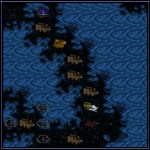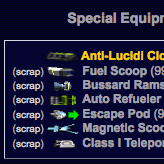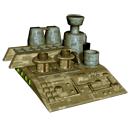How To Play Follow The Leader
Posted by SparkleAug 19
 When you are participating in a military operation (OP) in Pardus, it is very important to follow the directions of the OP Leader (and to remain quiet as you listen for directions or watch for a message etc).
When you are participating in a military operation (OP) in Pardus, it is very important to follow the directions of the OP Leader (and to remain quiet as you listen for directions or watch for a message etc).
It is also important that you follow precisely any mapped route that is provided to you (usually in the lead up to the OP).
A pilot acting as a “Breaker” will have travelled this exact route moments before you move – ensuring the route is safe and there are no Time Bombs or ambushes waiting to create trouble as you pass over them.
Travelling as a large group is sometimes referred to as “Follow the Leader” and it is very easy skill to learn.
Follow The Leader
If this is your first time travelling in a large group, a little practice and a few simple rules that everyone can understand will help to ensure your safety (and those travelling with you).
Rule One – Once the “Leader/Breaker” is moving, nobody is allowed to click on them. This may hide them from the view of other pilots and lead to confusion.
Rule Two – When travelling a mapped route, everyone should click just one tile ahead of them at a time – not multiple tiles. This will make it less likely that someone will click off the safe route.
Each pilot should aim to maintain a steady pace of clicking that suits their own response times.
Pilots will experience different amounts of “lag” as they travel along a route which will eventually cause some pilots to move ahead and some to fall behind a little (see the image at the top of the page).
A slower pace is much safer than fast “panic clicks” as you try to catch up. It is too easy to stray off the mapped route that way.
Try with using a 1 second delay between each tile that you click to. If you experience “lag” or start to get slow/erratic responses through the browser, increase the delay between each tile click to slow down your pace a little.
Rule Three – When travelling through uncharted territory without a mapped route, each pilot should aim to keep the “Leader/Breaker” on their navigation screen at all times. This may require the “Leader/Breaker” slow down his pace to accommodate the slowest pilot. He may need call out building names as he travels successfully under each one – so you need to be paying attention at all times.
Clear directions and concise communication is required from the “Leader/Breaker” – and each pilot needs to ensure they reciprocate and can understand what is happening at all times.
Rule Four – Remaining calm is the key to success when travelling as a large group (with a mapped route, or not).
If you can keep a regular steady pace as you click tiles (and discipline yourself to travel only 1 tile at a time on a mapped route), you will be less tense, more focussed and less likely to click the wrong tile (and possibly end up dead).
Practice makes perfect
You can practice travelling a mapped route yourself – and you should be comfortable with doing so before your first big OP.
If you can find other pilots willing to practise with you, take turns as the Leader as you follow one another through different sectors. This exercise requires discipline from the Leader as much as those following… and practise makes perfect in this case.
Remember the rules
- Don’t click on the Leader
- Click just one tile ahead of you at a time
- Keep the Leader in view at all times
- The Leader needs to keep you in view too
- Only click the tiles that have been clicked by the Leader
Make sure you steer well clear of any danger zones as you practise… and enjoy being part of a team working to a common goal!
 You scrap an item by clicking the “(scrap)” link beside any weapon or special equipment when in the Ship tab of the Overview page. You are prompted with the typical “Are you sure…” message and if you continue the item will be removed from your ship. It will be scrapped.
You scrap an item by clicking the “(scrap)” link beside any weapon or special equipment when in the Ship tab of the Overview page. You are prompted with the typical “Are you sure…” message and if you continue the item will be removed from your ship. It will be scrapped. Since it’s recent introduction, several solutions have been attempted in an effort to reduce the impact that the Credit Hack is having on pilots everywhere.
Since it’s recent introduction, several solutions have been attempted in an effort to reduce the impact that the Credit Hack is having on pilots everywhere. The
The  Your local MClass planet is suffering high Food prices (making your upkeep costs spiral out of control). You don’t want to let your
Your local MClass planet is suffering high Food prices (making your upkeep costs spiral out of control). You don’t want to let your  Commanding a Starbase doesn’t end once you have upgraded from a Trading Outpost. Failure to keep the worker population supplied with Food and Water will cause them to leave.
Commanding a Starbase doesn’t end once you have upgraded from a Trading Outpost. Failure to keep the worker population supplied with Food and Water will cause them to leave.